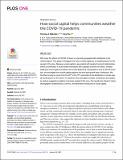How social capital helps communities weather the COVID-19 pandemic
Author(s)
Makridis, Christos Andreas; Wu, Cary
Downloadjournal.pone.0245135.pdf (1.032Mb)
Publisher with Creative Commons License
Publisher with Creative Commons License
Creative Commons Attribution
Terms of use
Metadata
Show full item recordAbstract
Why have the effects of COVID-19 been so unevenly geographically distributed in the United States? This paper investigates the role of social capital as a mediating factor for the spread of the virus. Because social capital is associated with greater trust and relationships within a community, it could endow individuals with a greater concern for others, thereby leading to more hygienic practices and social distancing. Using data for over 2,700 US counties, we investigate how social capital explains the level and growth rate of infections. We find that moving a county from the 25th to the 75th percentile of the distribution of social capital would lead to a 18% and 5.7% decline in the cumulative number of infections and deaths, as well as suggestive evidence of a lower spread of the virus. Our results are robust to many demographic characteristics, controls, and alternative measures of social capital.
Date issued
2021-01Department
Sloan School of ManagementJournal
PLoS One
Publisher
Public Library of Science (PLoS)
Citation
Makridis, Christos A. and Cary Wu. (2021) How social capital helps communities weather the COVID-19 pandemic. PLoS ONE 16(1): e0245135
Version: Final published version
ISSN
1932-6203